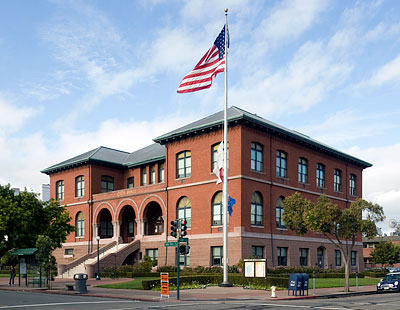National Register of Historic Places in Alameda County
Alameda City Hall
Santa Clara Avenue and Oak Street
Alameda
Built 1895-1896
Alameda City Hall is the major civic landmark remaining from the city's initial period of economic prosperity created by the expansion of the railroad network in the closing decades of the 19th century.
Constructed a little over twenty years after the City received its charter in 1872, the building summed up the civic aspirations of the Alameda citizenry. Because the City of Alameda was the first in California and the second in the United States to operate its own power plant, opened in 1886, the City Hall had the benefit of incandescent lighting, a significant luxury.
The building originally had a two-story clock tower rising above the central portion of the main facade. The tower had round-arched windows and shallow balconies on the upper story and a hipped roof with bracketed cornice. Damaged in the 1906 earthquake, the tower was removed in 1937. The base section remains above the entrance porch.
As conceived by George Percy of the firm of Percy & Hamilton, the design reflects the current fashion for the Romanesque Revival Style initiated in this country by Henry Hobsen Richardson and used in his famous Allegheny County Courthouse. The Alameda City Hall modestly echoes that building in its general format.
Percy & Hamilton designed about two hundred buildings in the San Francisco Bay Area including the notable Stanford University Art Museum and the Children's Playhouse in Golden Gate Park.
